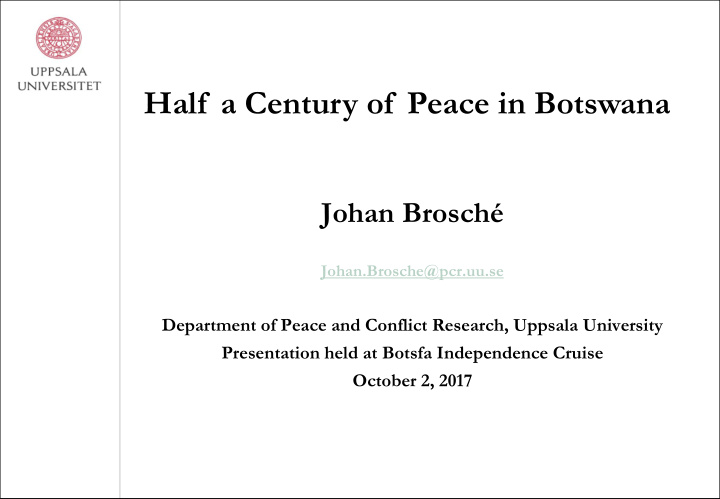



Half a Century of Peace in Botswana Johan Brosché Johan.Brosche@pcr.uu.se Department of Peace and Conflict Research, Uppsala University Presentation held at Botsfa Independence Cruise October 2, 2017
Aims of this presentation • Briefly present the project Causes of Peace – The Botswana Zambia and Malawi “Zone of Peace” . • Describe some characteristics of Botswana’s peace. • Outline some factors that we believe are important in explaining why Botswana has been spared from armed conflict. • Make use of the extensive knowledge in the room to discuss these factors.
Countries in Africa NOT Affected by Armed Conflict (1946-2015, interstate and intrastate) Zone of Peace : Zambia Botswana Malawi Source: Uppsala Conflict Data Program
Zone of Peace: Botswana, Zambia and Malawi • Africa is the world’s most conflict -affected region and have experienced one third of all inter- and intra-state conflicts since 1946. • Inhabitants of Botswana, Malawi and Zambia, comprise 73% of the African population that lives in a country that has not experienced armed conflict. • Extensive differences between these countries regarding issues like stability, poverty, and resources which make them more interesting to examine. • In sum, Zambia and Malawi’s peace is theoretically more surprising than Botswana’s.
Botswana’s Peace: Stable but Unequal • Stable Peace – No evident critical junctures when a more violent path was imminent. – No really powerful challengers to the prevailing status quo. – Same party in power since independence. President has extra- ordinary power: head of state, head of government, leader of ruling party, commander-in-chief and, in practice, select his successor. • Unequal Peace – Botswana is one of the most unequal countries in the world (Gini coefficient). – About one fifth of the population lives in absolute poverty (less than 2 US$/day). – Some communities, the San in particular, are severely marginalized.
Colonialism and the Non-Violent Path to Independence • Pre-colonial: developed and well-structured Tswana kingdoms. • Colonial: comparatively light colonial footprint (protectorate not colony) – the precolonial institutional structures were kept and developed. – Struggle for independence peaceful and sovereignty achieved without throwing a stone. • Post-colonial: not so sharp contrast to previous structures - many remained similar. – Good relations with the Brits.
Ethno-regional Relations • Dual effect of Tswanaification. – Created grievances and false impression that Botswana is ethnically homogenous. – Meant that many groups didn’t want to strongly emphasize its cultural distinctiveness. • Ethnolinguistic, socioeconomic, and regional divisions that are both substantively important and long-standing. - The most marginalized groups lack means to severely challenge the state. - Identities are generally multilayered and mutually exclusive identities hardly exist.
Elite Dynamics “Botswana’s diamonds – like its cattle industry – have been successfully integrated into the state-centered political economy in ways that … contributed decisively to bringing the major elites of the country together in a persistent and strong interest in political stability and societal peace and order” (Gulbrandsen, 2013, p. 8). - Balance between tradition and modernity. - Nationalization of resources before diamonds were discovered. - Domination of a consensus-seeking approach to government which had deep roots in Tswana culture.
Other Explanations • The Kgotla constitute an important system for conflict resolution. • General economic development has decreased the incentives for groups to organize protest. • Botswana’s type of diamonds less conflict prone than other types. • Professionalism of the army.
Questions to you? • Other explanations for Botswana’s peace you think are important? • Any particular critical junctures when a more violent path was possible that you think is important to study? • Has Botswana performed better – or worse – than what could be anticipated given its conditions?
Thank you for your attention! 11
Recommend
More recommend